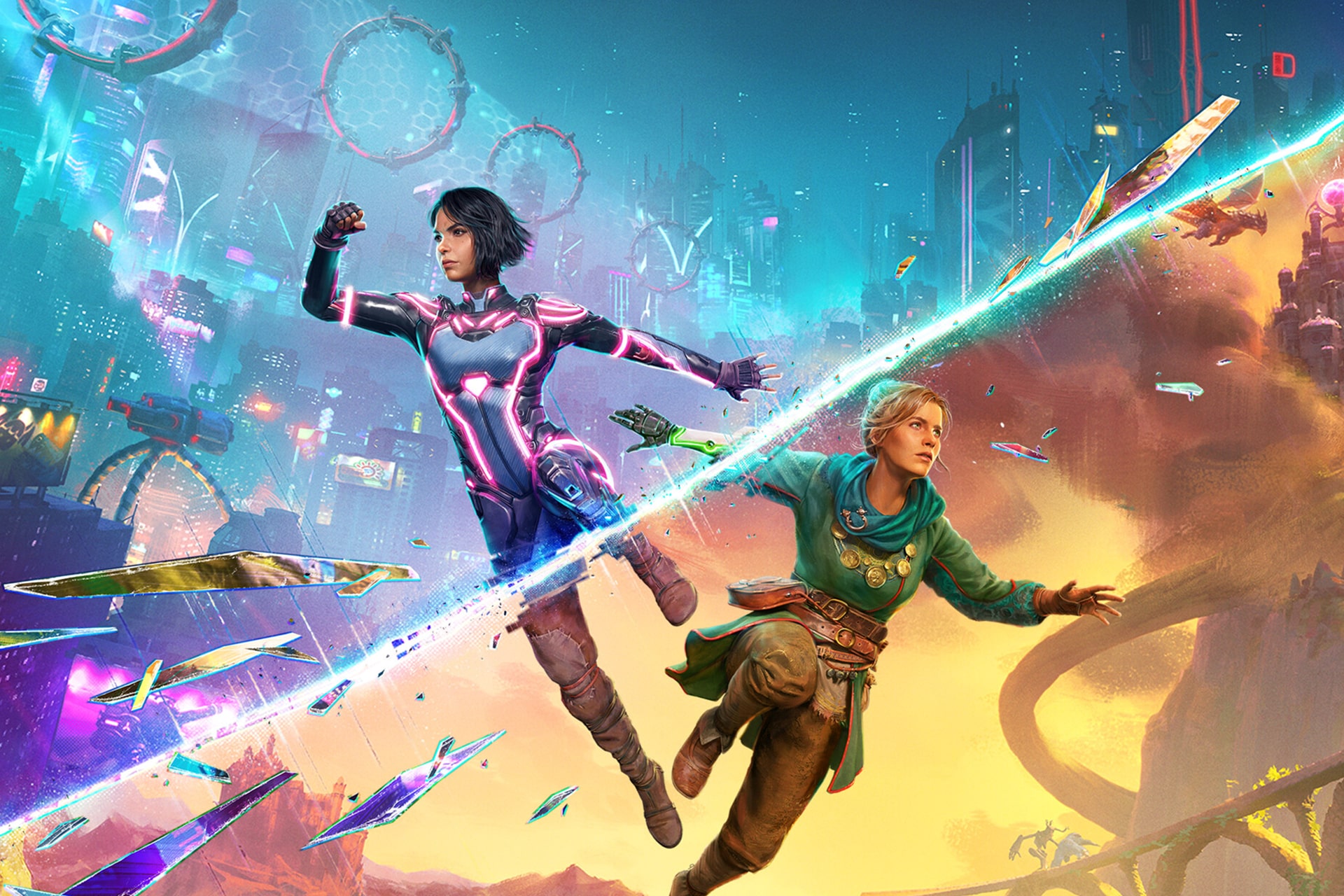Split Fiction keeps co-op gaming fresh, but Hazelight may be running out of tricks
1 day ago
Four years ago, It Takes Two surpassed one million copies sold just a month after its release. Thanks to its refreshing gameplay and notable quality, it went on to win the top prize at The Game Awards (TGA), almost becoming synonymous with two-player games. However, when reflecting on that year’s TGA, many media outlets and players remember it as a year where the best of a mediocre bunch took the prize.
In stark contrast to this perception is the game’s phenomenal success in China.
Josef Fares, the creator of It Takes Two, once mentioned that nearly half of the game’s sales came from China. This success is best reflected in the game’s symbiotic relationship with China’s console gaming industry.
This reminds me of something: Three years ago, I stumbled upon a gaming cafe in my hometown—a small fifth-tier city that didn’t even have a Luckin Coffee at the time. To my surprise, out of the eight consoles available, five were running It Takes Two. The owner admitted that half of his customers came specifically for that game. During busy times, such as summer and winter breaks, he sometimes even ran out of game discs.
What shocked me even more was what he said next—his store was actually opened because of the game’s explosion in popularity. It wouldn’t be an exaggeration to say that the success of It Takes Two led to the surge of console gaming cafes across China.
Even now, avid players of It Takes Two can still be found in gaming cafes, big and small. In the resting areas of large shopping malls, on self-service gaming machines with knockoff Xbox 360 controllers, you can often spot the game on the most prominent screen. Young passersby, whether out of curiosity or simply to kill time, can scan a QR code and, for a hefty fee, enjoy 30 minutes of gameplay.
Calling it a crowd-pleaser isn’t an overstatement—but after all, it’s been four years.
Gaming cafes that thrived because of It Takes Two have since closed due to operational challenges. And I, too, have played through the first level of this game with five different friends. Both gaming cafes and players are eager for a new two-player experience, a fresh dose of excitement.
Split Fiction, the latest masterpiece from Hazelight Studios, arrives right on cue. It quickly hit a commercial milestone upon launch, selling over one million copies in two days, with overwhelmingly positive reviews on Steam.
Even the usually critical gaming media were generous with their praise this time, showering Split Fiction with accolades. GameSpot, IGN, and several other media outlets gave the game glowing reviews, with its average media rating above 90 thus far.
It looks like Hazelight is poised for both critical and commercial success this time.
After nearly four days of immersing in the game, I can confidently say that Split Fiction delivers a unique charm and immense gaming enjoyment. Some of its innovative designs even push the boundaries of what’s possible in cooperative games.
It’s safe to say that Split Fiction has almost guaranteed itself a nomination for the top prize at this year’s TGA. However, some flaws in its game design leave us with slight concerns about the future of Hazelight’s split-screen co-op games.
“The most familiar stranger”For players who have experienced It Takes Two, Split Fiction may feel like “the most familiar stranger.”
The familiarity lies in the fact that Split Fiction replicates almost all of the gameplay designs and successful elements of its predecessor. The game builds its foundation on basic platforming and puzzle-solving while blending various genres, including shooting, bullet hell, racing, action, stealth, and party games. These styles are interwoven, with gameplay constantly shifting to keep players on their toes.
It feels as though Hazelight used an exhaustive approach to revisit the entire history of video games, extracting every possible gameplay mechanic, modernizing it, and scattering it throughout the game’s narrative.
However, the strangeness comes from the game’s pacing. Unlike the structured ebb and flow of It Takes Two, Split Fiction floors the gas pedal and never lets up. With non-stop rapid gameplay changes, players could stay hooked for hours on end.
The game is divided into eight chapters. Besides the prologue and the final conclusion, there are six main environments.
In the second chapter, players step into the shoes of cyber ninjas, guiding Mio and Zoe as they wield katanas and gravity hammers to fight their way through a neon-lit cyberpunk world. The third chapter switches things up completely, where players transform into a hammer-wielding gorilla, a swimming dragonfish, a gliding sprite, and a powerful treant. Each possesses unique transformation abilities that must be used in tandem to solve puzzles. In later chapters, players encounter 3D shooters, side-scrolling shooters, and even three-dimensional pinball—all appearing one after another.
Just when players start getting used to one gameplay style, it vanishes, only to be replaced by something entirely new, keeping the experience consistently fresh.
Beyond the variety of gameplay, each chapter’s artistic design showcases distinct visual styles. From neon-lit cyberpunk cities and misty enchanted forests to the cold, dangerous industrial future and the majestic realm of dragons, each environment offers vastly different visual tones, lighting, and artistic flair.
Fares wasn’t satisfied with just that. Within these six main chapters, he inserted several visually distinct side quests to balance the game’s pacing.
When the main plot is sci-fi, the side quests take on a fantasy theme, and vice versa. Players will traverse a Hogwarts-style magical world, an appetite-inducing candy world, a dune-covered desert, a perilous zero-gravity space station, and even an interactive sketch-like art world. Each of these breathtaking visual marvels flashes by, lingering in the player’s experience for only five or six minutes before disappearing for good.
With such relentless gameplay variety and ever-changing visuals, Split Fiction creates a rhythm reminiscent of short-form video content, turning into an attention magnet that players can’t tear their eyes away from.
But this approach comes at a cost. It means that the intricately designed environments that took the team countless hours to create are only visible to players for a few fleeting moments. In an industry increasingly focused on asset reuse and development efficiency, this approach is almost swimming against the tide.
Moreover, Split Fiction’s gameplay design evokes a sense of old-school charm from the early 2000s. It emphasizes creativity, meticulous polishing, and a focus solely on delivering a rewarding gaming experience—no microtransactions, no downloadable content (DLC), and no reskinned assets. This handcrafted quality, apart from Nintendo and a few exceptional indie games, is becoming a rarity in the present-day.
However, as a product backed by Electronic Arts, the game still carries traces of industrialization. Whether it’s the exquisite art assets and models or the advanced lighting effects, Split Fiction maintains standards aligned with the echelons of the game development world. Moreover, the game doubles down on cinematic presentation and narrative, with dazzling visuals that bombard the senses and leave players in awe.
To achieve this, Split Fiction’s development costs were double those of its predecessor, and the engine was upgraded to Unreal Engine 5 to ensure better visuals and lighting effects. The entire project took over three years to develop, comparable to a full-fledged AAA game.
Balancing creativity and difficultyIf this were all there was to Split Fiction, it would simply be an upgraded version of It Takes Two. However, in the game’s final chapter, the boundaries of creativity are seemingly tested, seeking to elevate the game’s fun factor to new heights and unlock new possibilities for split-screen co-op games.
From A Way Out to It Takes Two and now Split Fiction, Hazelight has established a default paradigm for split-screen co-op.
The split-screen line divides the screen down the middle, restricting each player’s actions to their respective halves. At most, players occasionally glean additional information from their partner’s side to assist with puzzles. Except in certain non-split-screen moments, this dividing line remains a constant presence, firmly separating the two players’ spaces.
But what happens when this paradigm is shattered?
In the final chapter, the split-screen boundary is completely dissolved. The sci-fi and fantasy worlds unfold simultaneously on both sides of the screen. In the sci-fi world, a deadly laser may occupy the same space where, in the fantasy world, there’s a clear path. Players can switch between these two worlds, using this mechanic to solve puzzles.
Being able to freely traverse between the two worlds deepens the sense of cooperation between the players.
But the game doesn’t stop at simply breaking the boundary. The split-screen line can appear anywhere—sometimes there’s one, sometimes two, and it can move to any position on the screen. This completely overturns previous expectations, paving the way for new gameplay possibilities. Anyone who has played through the final chapter probably can’t help but look forward to Hazelight’s next project.
More importantly, even with such bold creativity, Hazelight has maintained a delicate balance in Split Fiction’s difficulty, ensuring the overall experience remains rewarding for both players.
Creative gameplay often raises the learning curve, making the experience more complex and, at times, frustrating. However, Hazelight has struck a careful balance between innovation and difficulty, keeping seasoned players engaged while ensuring the game remains accessible for newcomers. This thoughtful approach helps preserve the game’s broad appeal, maintaining its popularity across diverse player demographics and securing its place in gaming cafes.
In challenging sections where creativity might increase the difficulty, Split Fiction doesn’t compromise by oversimplifying the gameplay to appease casual players—a move that often strips away a game’s sense of accomplishment. Instead, the game seeks to optimize the players’ feel of the controls.
A perfect example is the bomb-catching sequence in a side quest. During this section, both players need to pass a timed bomb back and forth while navigating an obstacle course. This means keeping track of the bomb’s countdown while simultaneously performing precision platforming and timing throws perfectly.
This is a difficult challenge to balance, and it could easily become a frustrating roadblock.
However, Hazelight softened the difficulty by increasing the bomb’s auto-catch radius and adding subtle auto-lock assistance when throwing. Paired with excellent throw-and-catch mechanics, this results in a scenario where—even as beginners—players feel like they are pulling off some truly cool moves!
Compared to cooperative games like Overcooked, Split Fiction’s difficulty remains well within a manageable range. Overcooked’s chaotic gameplay often exhausts players after just a few rounds, while Split Fiction consistently gives players the feeling that one more try will suffice.
Another detail worth noting: Hazelight avoids back-to-back difficult levels.
After solving a challenging section that requires quick reflexes or problem-solving, the game usually follows with a relaxing interlude—whether it’s a simple lock-pulling task or bouncing between strong adhesive platforms. This design approach keeps players immersed in a state of flow, while a steady stream of positive reinforcement strengthens the bond between them.
Outstanding cinematic storytelling, but…Fares, despite his background as a film director, still struggles to break free from formulaic and conventional storytelling in Split Fiction. The result is a script that feels like a cookie-cutter Hollywood blockbuster, paired with a narrative that lacks the immersive depth found in top-tier interactive storytelling.
The game’s two protagonists are a pair of complementary writers. One is a reserved, realist sci-fi enthusiast, and the other an extroverted, romantic fantasy lover. Through their unexpected adventure, they gradually understand each other and forge a deep friendship. Along the way, they also confront and heal the wounds left by their dysfunctional childhoods.
Ironically, despite Fares’ infamous rant against the Oscars at TGA, Split Fiction’s story feels no different from the predictable plots of mainstream Hollywood films.
But the bigger issue lies in the game’s narrative approach.
Although the game’s cinematic storytelling is visually spectacular—complete with thrilling chase sequences, explosions, hijackings, last-second rescues, and perfectly timed camera work—it ultimately relies too heavily on cutscenes. Unfortunately, this comes at the expense of interactive narrative, marking a regression from its predecessor.
Interactive storytelling occurs when the narrative unfolds through gameplay. In The Last of Us, for example, Joel and Ellie’s journey gradually deepens their bond through shared challenges, ultimately leading to Joel’s morally complex decision to save Ellie over the world. Without this, the narrative would merely be a typical Hollywood road movie.
The magic of interactive storytelling lies in the moments where Ellie saves Joel from danger, offers helpful hints during puzzles, or shares heartfelt conversations during quiet moments. This continuous companionship during gameplay allows players to empathize with Joel’s final decision.
It Takes Two achieved a similar narrative effect.
In the game, May and Cody’s marriage was on the brink of collapse. The game subverted traditional gender roles: May was the breadwinner and family provider, while Cody was a stay-at-home dad managing household chores. This character dynamic was consistently reflected in the game’s mechanics. May wielded the hammer, handling combat, while Cody used the nails, focusing on support. Throughout the game, their division of labor reinforced this theme, making the emotional stakes resonate deeply with players.
However, Split Fiction falls short in this regard.
The introverted-extraverted dynamic between Mio and Zoe is barely reflected in the gameplay. Their contrasting personalities—one impulsive and the other cautious—only emerge through cutscenes and dialogue. With a weaker connection between narrative and gameplay, the abundance of cutscenes becomes an opportunity for players to check their phones. As a result, the emotional connection to the two protagonists is far less impactful than what players experienced with May and Cody.
Is there room left for Hazelight to innovate?All in all, even amidst a crowded 2025 release schedule, Split Fiction has secured a likely spot in the TGA nominations. Hazelight’s mastery of the split-screen co-op genre remains unmatched, and the creativity showcased raises expectations for its next project.
However, it’s important to acknowledge that no matter how expansive the gameplay mechanics are, there’s always a limit.
The real challenge lies in stitching together diverse mechanics without making the experience feel disjointed—and ideally, adding a fresh twist. As the game progresses into the later chapters, especially the fourth and fifth chapters, a noticeable sense of repetition begins to creep in.
The constant high-paced gameplay can also lead to fatigue and information overload for some players. Hazelight has now leaned on this approach of “throwing everything at the player” across three consecutive games, relying on an overwhelming variety of mechanics to sustain the feeling of novelty.
As the saying goes, the third time’s the charm. If Hazelight’s next co-op game continues down this path—exploring every conceivable gameplay style to keep players engaged—it begs the question: is there any room left to innovate?
KrASIA Connection features translated and adapted content that was originally published by 36Kr. This article was written by Xue Dexing for 36Kr.
...Read the fullstory
It's better on the More. News app
✅ It’s fast
✅ It’s easy to use
✅ It’s free









